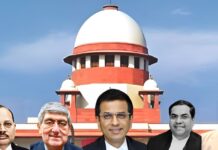The administration appears as clueless and helpless about the unfolding catastrophe as the ordinary people, writes Riyaz Wani

With over three lakh Covid-19 cases a day, things seem to be falling apart in India. The healthcare system has been pushed to the breaking point. The viral videos and images of the hospitals refusing the admission of even the critical Covid-19 patients paint an apocalyptic picture of the existing state of affairs. This has, as a result, led to a sharp rise in fatalities. So much so, that there is neither enough space nor wood in cremation grounds in Delhi to cremate the dead. This is necessitating the mass cremations, some of them in car parks.
Going forward, the situation looks unlikely to improve. Bhramar Mukherjee, professor of Epidemiology, Michigan University in an interview with Karan Thapar predicted that India’s daily cases could jump to 5 lakh by May 1 and by mid-May the figure could touch 8-10 lakh a day. Similarly, she has predicted the number of deaths to rise from 3000 to 4500 a day. This would be a deluge and could lead to a complete institutional collapse. But the tragedy is the government appears as clueless and helpless about the unfolding catastrophe as the ordinary people.
Already, hospitals around the country are reporting severe shortages of beds and medical oxygen. Governments in Maharashtra and New Delhi have been forced to impose restrictions on movement. Delhi is currently under a weeklong curfew and the government there will have little option but to extend the restrictions.
No Suggestions
The government, meanwhile, has retreated from the scene. The Prime Minister, Narendra Modi, in his recent address to the nation had nothing in terms of a concrete plan of action to tide over the crisis. He said the states should consider the lockdown as “the last option”, urging them to focus on micro-containment zones. Last year, the PM had imposed lockdown at a short notice of four hours and gone on to extend it for over two months. In the process the lockdown crippled the economy, denting the Gross Domestic Product by one-fourth. On the ground, it meant the destruction of businesses and the loss of lakhs of jobs. So, it was understandable that Modi stayed short of calling for yet another lockdown but there was nothing in his speech that could be called as an alternative strategy. He virtually put the ball in the court of the state governments. And the states themselves are in no position to reign in what has become a runaway pandemic. But resting on one’s hands is no option. At the current rate of growth of infections, the pandemic will consume the whole country.

The union government is rightly being blamed for facilitating the virulent second wave by allowing super-spreader election rallies and religious festivals like Kumbh mela. But as is apparent now, the government has been caught unawares by the resurgence of the virus, much like it was during the first wave. The country had got a reprieve during winter with daily cases going drastically down but the period was not used to accelerate vaccination. Instead, the government chose to donate vaccines to other countries to increase the country’s diplomatic clout. As a result, the vaccination was slow to pick up creating conditions for the second wave.
Although the centre has halted all vaccine exports, many states don’t have adequate’ supply left in stock. Now the union government is trying to make up for the lost time by approving more foreign vaccines for emergency use. India wants Pfizer, Moderna and Johnson & Johnson to seek a licence for their Covid-19 vaccines as soon as possible. Besides, the centre has given approval to the Russian vaccine Sputnik V and also the Chinese variant.
Kashmir Situation
In Jammu and Kashmir, the situation has been no different. Our daily cases are already twice the peak of the last year. Things are likely to get difficult in near future. In J&K too, the administration is blamed for creating conditions for the spread of the virus by sponsoring cultural festivals and fashion shows, besides allowing unchecked tourism.
Now that the virus has once again taken hold, it is incumbent on the administration to pay more attention to vaccination with Srinagar, which has been consistently recording the maximum number of cases being prioritised in the effort. The need is to set up more vaccination centres in the city to make it easier for people to receive vaccine doses.

Also, the administration will have to run an aggressive awareness campaign about the disease. It has to also work towards the involvement of the community by charging village, locality elders, mosque managements etc to ensure people follow the safety precautions. Government should also enlist the youth for the purpose. This will go a long way to make a redeeming difference to the attitude of the people towards the contagion and thus help in arresting its further spread.
That said, the administration should resist the temptation to go for yet another lockdown. Considering its disastrous fallout on the economy, the lockdown has become a bad word. It is no longer advisable for people and the economy to remain in a perpetual state of paralysis. This has already wrought havoc with the economy. More so, in Valley, which has been under lockdown for a better part of the last two years.















